
Jonathan Leak: From Convict to Master Potter in Sydney
A stoneware ginger beer bottle, made in Sydney by Jonathan Leak at his Brickfield hill pottery in the 1820s. It is a rare example of the earliest surviving marked pottery made in Australia, impressed stamp 'Leak' to shoulder, 18 cm high. At the age of 42,…

Sydney antique pottery ginger beer bottle with factory mark
T. Field potter, Sydney antique pottery ginger beer bottle, factory mark to side, 16.5 cm high

1850s Sydney Ginger Beer Bottle by T. Field Pottery
Thomas Field (Sydney), antique pottery ginger beer bottle, circa 1850s, impressed 'T. Field Pottery, Sydney', 16 cm high

Singleton Ginger Beer Bottle with Batsman Moulding
Alex Mather & Sons Brewed ginger beer bottle, Singleton, early 1900s, with moulded image of a batsman, height 17 cm

Antique Pottery Storage Bottles Collection
Five early pottery storage bottles including: Brownsons Eccles stout; Reed Brothers ginger beer; Edge ginger beer; etc.

Tooheys Stoneware Ginger Beer Bottles (Pair, 17cm)
A pair of Tooheys stoneware ginger beer bottles. Height 17 cm.

Fitzroy Stoneware Bottle and Tramp Art Frames
R. Harrison of Fitzroy stoneware ginger beer bottle, and a pair of tramp art picture frames, late 19th and early 20th century, (3 items), the bottle 22 cm high
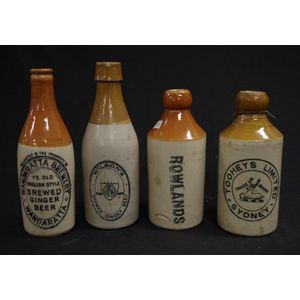
Antique Ginger Beer Stoneware Bottles Collection
Four antique ginger beer stoneware bottles comprising of E. Rowlands Pty Ltd 17.5 cm, Wilson's 21 cm, chip to top, Toohey;s Ltd Sydney 17.5 cm and Wangaratta Brewery 20.5 cm

Antique Ginger Beer Stoneware Bottles - Set of Four
Four antique ginger beer stoneware bottles comprising of Albury Brewing & Malting Co 17.5 cm and Oswald & Metcalf Eaglehawk 21.5 cm, chips to top and 2@ Manger & O'Neill Echuca 18.5c,

Abbott's Old English Ginger Beer Demijohn - Phoenix Label
Abbotts demijohn, Old English ginger beer, Bendigo, phoenix label, 33 cm
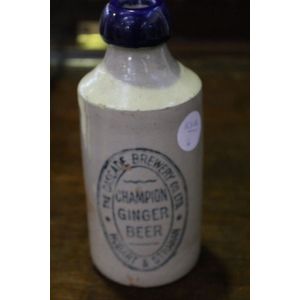
Champion Ginger Beer Stone Bottle - Hobart & Strahan
Champion ginger beer stone bottle, Hobart and Strahan

Abbott's Ginger Beer Demijohn with Phoenix Label - 33cm
Abbotts demijohn, Old English ginger beer, phoenix label, 33 cm

Cascade Cordials Stoneware Ginger Beer Bottle
A stoneware ginger beer bottle, 'Cascade Cordials limited north Sydney'. Height 19 cm.

Batsman Bottles: Lemonade and Ginger Beer
Alex Mather Singleton Three Lemonade and Ginger beer bottles each with moulded image of a batsman.

Two-tone Ginger Beer Crocks with Metal Handles
Two early ginger beer crocks, two-tone glaze, Bainbridge Brothers Auckland and Sharpe Brothers, Australia & New Zealand, chips to base of one, both with metal handles. Height 34 cm

Early NZ Ginger Beer Bottle by George Dixon, Wellington
An early New Zealand blob top ginger beer bottle, impressed mark to the side for George Dixon, Cuba St, Wellington. Height 17 cm
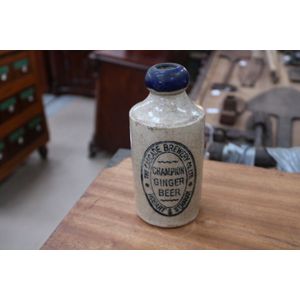
Champion Ginger Beer by Stone Cascade Brewery
Stone Cascade Brewery Champion ginger beer bottle Hobart & Strahan

Bourne-Denby Ginger Beer Bottle by Kelly & Co. Hobart
Kelly & Co stone Hobart ginger beer bottle, Bourne-Denby

J. Ladd's Stoneware Ginger Beer Bottles
A pair of stoneware J. Ladd's ginger beer bottles, Adelaide port & Gawler, height 17 cm

Koda Stoneware Ginger Beer Bottles with Sailing Ship Logos
Five New Zealand blue top vintage stoneware ginger beer bottles, all marked 'Koda', three with various sailing ship logos, all Christchurch, some restoration

Vintage New Zealand Ginger Beer Stoneware Bottles
Five New Zealand vintage ginger beer stoneware bottles; 'D J Barry Ltd Gisborne'. 'Thomson Lewis & Co... Steam Works...', ' C O Steffenson. New Plymouth' and 'Napier'. Some restoration

Fowler Ginger Beer Bottle, c1840s
Fowler Convict ginger beer pottery bottle, straight impressed mark on the shoulder. c1840s. 17 cm

Double Glazed Ginger Beer Bottle, 1840
Stephen greens double glazed ginger beer bottle, circa 1840. Stamped with Stephen greens patent double glaze Lambeth mark. Ochre colour measuring 16.5 cm tall. This mark has been seen and associated with a convict, Hobart bottle. Fleck to lip, chip to

Pair of Rare Sydney Ginger Beer Bottles by T. Field Potter
Two rare T. Field Potter Sydney ginger beer bottles (2)

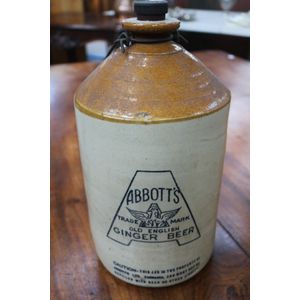



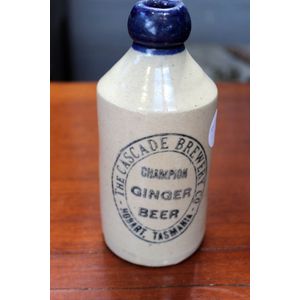
 Loading more...
Loading more...